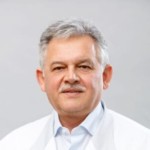Epidural blocks
The technique consists of injecting a medication (local anesthetic and/or corticosteroid) through a special needle into the lumbar spine at a site called the «epidural space» to relieve pain in the lumbar region, pelvis, and legs.
Local anesthetics and opioids are commonly prescribed to relieve acute, postoperative, and chronic pain. The professional experts of the clinic perform the procedure with local anesthesia. The common time of creating a block is three weeks, depending on the development.
Peripheral locks
The procedure consists of injecting a local anesthetic and/or corticosteroid into a nerve that is pinched or stretched caused by neuralgia.
This technique is performed on an outpatient basis and is simple. The doctor uses radiological control to locate the area and injects the selected medicine.
Intrathecal pumps
It is one of the safest and most efficient devices. It has been used over the decades to improve the quality of life of patients with chronic pain.
The technique involves implanting a catheter (a very thin plastic tube) that is inserted directly into the cerebrospinal fluid through a small incision in the back at the level of the lumbar spine.
The pain reliever is contained in a programmable pump, which can be external or implanted (usually inserted through an incision in the abdomen).
Whom this method can help?
It is prescribed for patients with severe pain and for patients with spasticity, for instance, people with multiple sclerosis.
The advantage of this method is that the drug is injected directly into the intrathecal space, where all the nerve pathways are located. At the same time, the required doses are much less than those to be used orally, which significantly reduces side effects.
Doctors perform the procedure under local anesthesia and under X-ray control.
Spinal stimulants
The experienced doctors of the HM hospital insert electrodes into the spine through a needle under X-ray control, which is connected to a battery (stimulator), and usually placed in the abdomen or in the upper gluteus muscle.
These electrodes generate low voltage electrical impulses that alter the transmission of nerve impulses, providing partial or complete pain relief.
The following method treats:
- Treatment of ischemic pain (phantom limb, anginal pain, etc.),
- Neuropathic pain (complex regional pain syndrome, pain from spinal cord injuries, etc.).
This method also requires local anesthesia to place the electrodes.
Iontophoresis
This method gives very good results with no complications for the patient.
Iontophoresis is a method that achieves a high concentration of a drug at a specific site of action and with minimal side effects.
An expert physician injects the drug through the skin with a direct current that allows greater penetration through the skin.
The main advantage is that it prevents drug toxicity in the liver, and when applied directly to the affected area, increases its effectiveness.
Most common indications:
- Postherpetic neuralgia,
- Trigeminal neuralgia,
- Carpal tunnel syndrome,
- Supportive inflammatory processes,
- Myofascial syndrome.
This procedure takes about 20 minutes and requires several sessions.
Radiofrequency
Radiofrequency is a technique when radio waves are sent through a needle to an area of a nerve.
Radiofrequency waves create an electric field that destroys the involved nerve tissue, suppresses the transmission of nerve impulses, and, as a result, relieves pain while maintaining motor function.
The most common indications for this technique:
- Trigeminal neuralgia,
- Cluster headache,
- Atypical facial pain,
- Pain due to the pathology of the lower back (Facet syndrome),
- Cervical syndrome,
- Chronic shoulder pain,
- Intercostal neuralgia,
- Incurable malignant pain,
- Hyperhidrosis.


